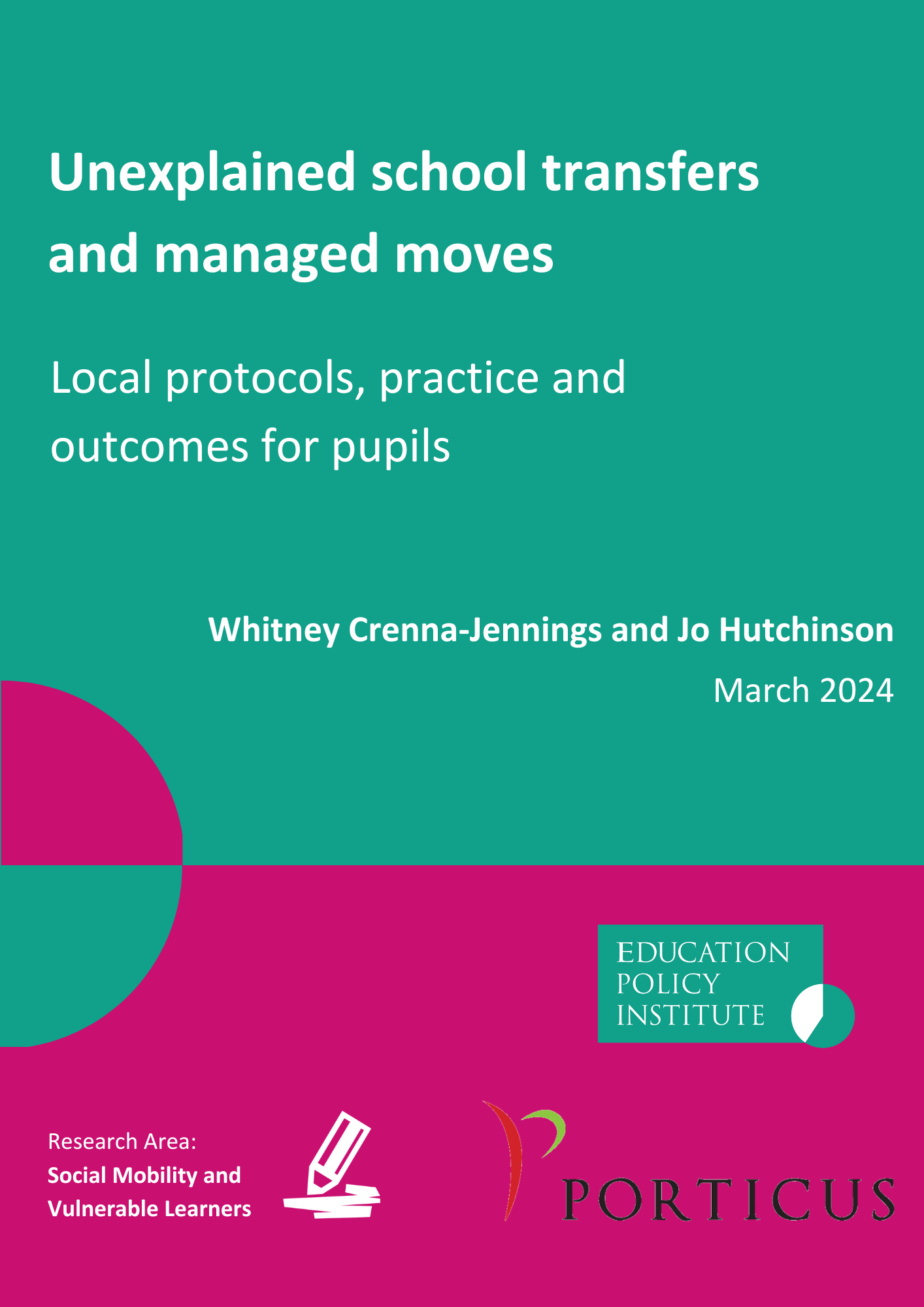This report examines the prevalence of school moves, including managed moves, their impact on pupils, and the protocols that local authorities have in place to govern them.
Key findings:
Thousands of secondary pupils experience a school transfer which does not appear to be driven by family decisions.
- 34,000 pupils finishing year 11 in 2019 (around six per cent of the cohort) experienced at least one unexplained school transfer at some point during their five years of secondary school. These moves did not occur due to any family reason we could detect in the data.
- 30,600 secondary pupils (around one per cent of all pupils in secondary schools) experienced an unexplained school transfer during the 2018/19 academic year.
Vulnerable pupils and those from some demographic groups are at increased risk of unexplained school transfers.
- Overall, one in seventeen pupils in the cohort finishing year 11 in 2019 experienced at least one unexplained school transfer, compared with:
- Almost one in five pupils with an identified social, emotional or mental health need.
- One in seven pupils who were persistently absent.
- One in ten pupils who were ever looked after by the local authority, designed as a ‘child in need’ or persistently disadvantaged.
- Almost one in ten pupils from Black ethnic groups.
There is significant variation in rates of unexplained school transfers between local authorities.
- Local authority rates of unexplained school transfers in 2018/19 ranged from 0.4 to 2.5 per cent of all pupils in the area.
There is significant variation in the approach to managed moves taken by local authorities.
- In our analysis of each local authority’s fair access and managed move protocol we found that:
- One in five local authorities did not have a managed move protocol, for example, a separate document or section of a fair access protocol laying out processes for managed moves.
- Some LAs treat managed moves as a last resort, whilst others used them as part of a supportive strategy specifically for children with additional needs.
- In fewer than a fifth of local authorities, protocols clearly stated that parental preference and the views and/or needs of pupils are factored into decisions. In two areas, we found explicit evidence that pupils could be excluded if parents did not agree to a managed move.
- The length of trial periods, during which a pupil is dual registered at the home and receiving school, can range from between four weeks to six months.
- In most areas, there is evidence of limited or no local oversight of managed moves. There is some indication that a lack of LA oversight may be related to insufficient resources and/or the academisation of secondary schools.
- However, we did not find a statistically significant relationship between the features of an LA’s approach to managed moves and the local rate of unexplained school transfers.
Many managed moves do not result in stable placements in new schools.
- Only around a quarter of local authorities held data on outcomes following managed moves happening across schools in their area. According to data from these LAs approximately three in five managed moves in secondary schools in 2018/19 resulted in the pupil returning to the home school. Some pupils went on to experience another move (22 LAs reported this), a permanent exclusion (19 LAs), or a move into home education (10 LAs) or AP (seven LAs).
Policy Recommendations:
- To enable proper oversight of school inclusion, a central data reporting system which captures all moves and the reasons for them, including managed moves and moves into home schooling, should be introduced. This would enable better monitoring and research of inclusion, including for children with protected characteristics, who are at increased risk of unexplained exits from the school system and moves between schools.
- Local authorities should monitor outcomes for pupils who experience managed moves, as our findings suggest that for many, a managed move may be the beginning of a process of exclusion from mainstream education which results in additional moves, permanent exclusion, or a move into alternative provision.
- Government guidance and policies regarding responses to behaviour challenges should be informed by the evidence around how to best support young people with mental health, emotional, and behavioural needs. It should recognise the complex causes of difficulties, including experiences of trauma, poverty, and unsupported additional needs, as well as the evidence suggesting school mobility is particularly harmful for vulnerable pupils’ outcomes.
- Local processes for administering managed moves should involve an independent representative of the child’s best interests. As we have previously noted in our unexplained exits work, this role cannot be effectively undertaken by local authority officials due to the conflict of interest they face as both the assessor of and provider/funder of support for special educational needs and disabilities support.
You can read the report in full here.

This report was funded by Porticus.
About Porticus
Porticus are a philanthropic organisation focused on creating a just and sustainable future where human dignity flourishes. Our work aims to strengthen the resilience of communities so that all people have ownership over their future.



